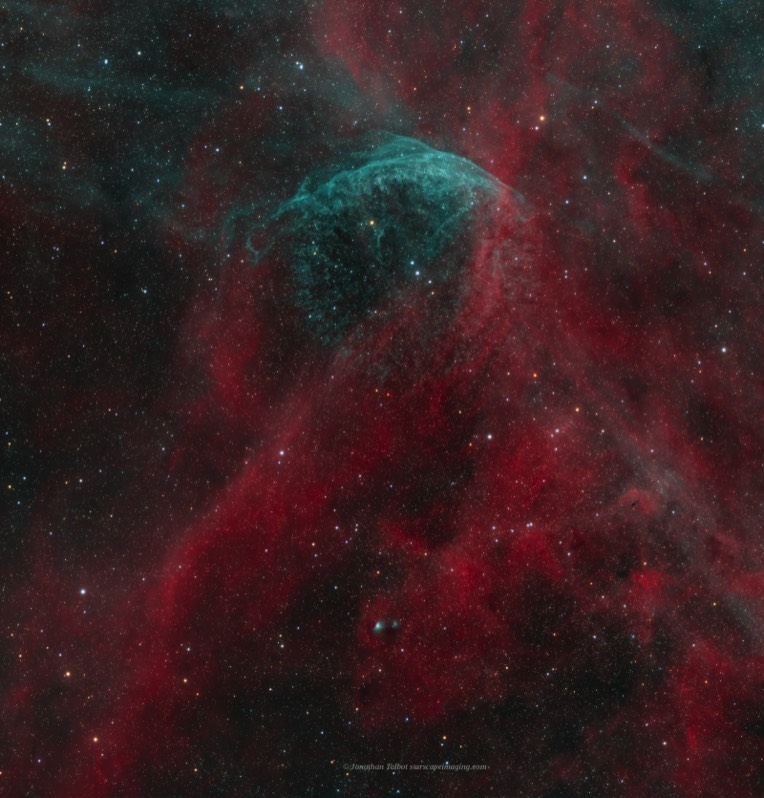A Wolf-Rayet Bubble around WR134 in Cygnus
Published 22 Aug 2021
Full image field here: Un-cropped full resolution
About this object
WR 134 is a Wolf-Rayet type star 6,000 light years distant in the constellation Cygnus which is surrounded by a faint bubble nebula created by the intense radiation and stellar winds from the star. WR134 is classified as an Algol type eclipsing variable and given the designation V1769 Cygni. The star is the whitish one near the center of the bubble. WR134 is extremely hot at 63,000K and is 400,000 times as luminous as our sun. In this image the bubble is shown in doubly ionized oxygen light (OIII) as the round blue/green area just above center. It takes on a brighter wispy look near the top and a more radiating look below that. It seems to almost form a nice circle. Other doubly ionized oxygen emission is scattered in faint streaks. Also the area is full of Hydrogen (HII) emission shown as the red clouds of gas. Two faint reflection nebula next to each other are also shown in the lower part of the image. The above image is a rotated crop of a larger field of view. The link to the uncropped and rotated image is above. Clicking on the image itself will display a full resolution view. The image combines 3hrs of RGB exposures and 16hrs of HII and over 20hrs of OIII exposures for a total exposure time of 47hrs. Image resolution is 1.28 arcsec/pixel.
WR 134 is a Wolf-Rayet type star 6,000 light years distant in the constellation Cygnus which is surrounded by a faint bubble nebula created by the intense radiation and stellar winds from the star. WR134 is classified as an Algol type eclipsing variable and given the designation V1769 Cygni. The star is the whitish one near the center of the bubble. WR134 is extremely hot at 63,000K and is 400,000 times as luminous as our sun. In this image the bubble is shown in doubly ionized oxygen light (OIII) as the round blue/green area just above center. It takes on a brighter wispy look near the top and a more radiating look below that. It seems to almost form a nice circle. Other doubly ionized oxygen emission is scattered in faint streaks. Also the area is full of Hydrogen (HII) emission shown as the red clouds of gas. Two faint reflection nebula next to each other are also shown in the lower part of the image. The above image is a rotated crop of a larger field of view. The link to the uncropped and rotated image is above. Clicking on the image itself will display a full resolution view. The image combines 3hrs of RGB exposures and 16hrs of HII and over 20hrs of OIII exposures for a total exposure time of 47hrs. Image resolution is 1.28 arcsec/pixel.
Image Details
- Optics : Stellarvue SVX 152T refractor @f8 1200mm FL
- Mount: Paramount MYT
- Camera: ZWO ASI6200
- Filters: Chroma 50mm RGB OIII Astrondon 50mm Ha
- Exposure (min): RGBHaOIII 205:195:200:980:1240 47.2 hrs, 2x2 binning
- Automation Control: The Sky X, Voyager, PrimaluceLab Eagle 4
- Guiding: StarlightXpress Lodestar X2
- Processing Software: PixInsight, Topaz Labs
- Location: Stark Bayou Observatory, Ocean Springs, MS
- Sky: Typical SQM 19.6-20.1, Bortle 5, Suburban
- Date: 20 July- 18Aug 2021







